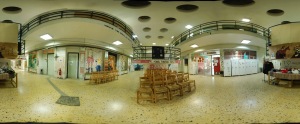john cage
the first impression
chaotic-noisy disorganized
Cage originally made his chance decisions by tossing yellow sticks or coins , according to practices described in the I think.
he later found found a more productive way

-categories of sounds (urban, wind,……-produced, manually produced sounds(including musical instruments) -what today looks as an easy assignment -recording literally hundred of sounds (barrons) -elements -sound recordings (equipment)



http://www.youtube-nocookie.com/embed/LAVQPUUiBN0?list=PL3A7AD14495922045
get sound forge-vegas// get open source audio programms
j
R650 All our o the synesthete subjects(S1–S4, ages 23–33, 1 woman) hadnormal visual acuity and no knownhearing or neurological decits. Theirvisually-induced sound perceptionsoccur automatically, cannot be turnedo, and have been experienced oras long as they can remember goingback into childhood. The percepts aretypically simple, non-linguistic sounds(such as beeping, tapping or whirring)that are temporally associated withvisual fashes or continuous visualmotion. Eye movements over astationary scene (retinal motion) donot typically evoke sound. In dailyexperience, all our subjects aregenerally able to distinguish theirsynesthetic sound percepts rompercepts induced by real auditorystimuli, but occasional conusionexists. We reer to this phenomenonas ‘hearing-motion’ synesthesia, eventhough non-moving visual fashesalso trigger sound perception asdemonstrated next.Our goal was to devise a task orwhich hearing-motion synesthesiawould coner a perormance advantage, as this would bestrong objective evidence or theperceptual experience[4]. Typically(in non-synesthetes), people have anadvantage in judging rhythmic patternso sound compared to equivalentvisual rhythmic patterns[7,8]. We thuspredicted that synesthetes wouldperorm better  than controls in a taskinvolving visual rhythmic sequencesbecause synesthetes would not onlysee, but also hear the patterns.
than controls in a taskinvolving visual rhythmic sequencesbecause synesthetes would not onlysee, but also hear the patterns.
The sound ochange: visually-induced auditorysynesthesiaMelissa Saenz and Christo KochSynesthesia is a benign neurological condition in humans characterized by involuntary cross-activation othe senses, and estimated to aectat least 1% o the population[1].Multiple orms o synesthesia exist,including distinct visual, tactile orgustatory perceptions which areautomatically triggered by a stimuluswith dierent sensory properties[1–6],such as seeing colors when hearingmusic. Surprisingly, there has beenno previous report o synestheticsound perception. Here we report thatauditory synesthesia does indeed existwith evidence rom our healthy adultsor whom seeing visual fashes orvisual motion automatically causes theperception o sound. As an objectivetest, we show that ‘hearing-motionsynesthetes’ outperormed normalcontrol subjects on an otherwisedicult visual task involving rhythmictemporal patterns similar to Morsecode. Synesthetes had an advantagebecause they not could not only see,but also hear the rhythmic visualpatterns. Hearing-motion synesthesiacould be a useul tool or studying howthe auditory and visual processingsystems interact in the brain.ASample ‘same’trial:interval 1:interval 2:Sample ‘different’trial:Sample rhythmic sequence composed of flashes or beeps:20050100Time (ms)interval 1:interval 2:p< 0.0001N.S.Controls(n=10)Synesthetes(n=4)B1009080706050 % c o r r e c tSoundVisionCurrent BiologyFigure 1. Visually-induced auditory synesthesia.(A) Sequences were composed o intermixed long (200 ms) and short (50 ms) duration stimuliseparated by blank intervals (100 ms) similar to Morse code (bars depict stimulus on-times). Thestimuli were either tonal beeps (360 Hz) on sound trials or centrally fashed discs (1.5 deg radius)on visual trials. On each trial, subjects judged whether two successivesequences (either bothsound or both visual) were the ‘same’ or ‘dierent’. (B) Mean perormance (% correct trials) orcontrol and synesthete subjects (+/− SEM). All subjects had good accuracy on sound trials, butsynesthetes dramatically outperormed controls on the otherwise dicult visual trials. Movies osample trials located online at http://www.klab.caltech.edu/~saenz/hearing-motion.html.thereore emerges whereby one othe key unctions o the intact basalganglia is to link positive outcomesto subsequent behaviour, whetherpredominantly cognitive or motorin its demands, and to modiy thisrelationship accordingto motivational state.Supplemental dataSupplemental data are available athttp://www.current-biology.com/cgi/content/ ull/18/15/R648/DC1 AcknowledgmentsThis work was supported by the MedicalResearch Council, Welcome Trust, FWO- Vlaanderen and Strategisch Basisonderzoek.Reerences1. Niv, Y. (2007). Cost, benet, tonic, phasic: whatdo response rates tell us about dopamine andmotivation? Ann. NY Acad. Sci.1104, 357–376.2. Satoh, T., Nakai, S., Sato, T., and Kimura, M.(2003). Correlated coding o motivation andoutcome o decision by dopamine neurons.J. Neurosci. 23, 9913–9923.3. Brown, P., Chen, C.C., Wang, S., Kühn, A.A.,Doyle, L., Yarrow, K., Nuttin, B., Stein, J.,and Aziz, T. (2006). Involvement o humanbasal ganglia in o-line eed-back control ovoluntary movement. Curr. Biol.16, 2129–2134.4. Hamani, C., Saint-Cyr, J.A., Fraser, J., Kaplitt,M., and Lozano, A.M. (2004). The subthalamicnucleus in the context o movement disorders.Brain127, 4–20.5. Frank, M.J., Seeberger, L., and O’Reilly, R. C.(2004). By carrot or by stick: Cognitivereinorcement learning in Parkinsonism.Science 306, 1940–1943.6. Shohamy, D., Myers, C.E., Onlaor, S. Grossman,S., Sage, J., Gluck, M.A., and Poldrack,R.A. (2004). Cortico-striatal contributions toeedback-based learning: Converging datarom neuroimaging and neuropsychology.Brain127, 851–859.7. Kemp, F., Brücke, C., Kühn, A.A., Schneider,G.H., Kupsch, A., Chen, C.C., Androulidakis, A.G., Wang, S., Vandenberghe, W., Nuttin, B.,et al.(2007). Modulation by dopamine o humanbasal ganglia involvement in eedback controlo movement. Curr. Biol.17, R587–R589.8. O’Doherty, J., Dayan, P., Schultz, J.,Deichmann, R., Friston, K., and Dolan, R.J.(2004). Dissociable roles o ventral and dorsalstriatum in instrumental conditioning. Science 304, 452–454.9. Wrase, J., Kahnt, T., Schlagenhau, F., Beck, A.,Cohen, M.X., Knutson, B., and Heinz, A. (2007).Dierent neural systems adjust motor behaviorin response to reward and punishment.Neuroimage 36, 1253–1262.10. Tricomi, E.M., Delgado, M.R., and Fiez, J.A.(2004). Modulation o caudate activity by actioncontingency. Neuron41, 281–292.1Department o Neurology and2Departmento Neurosurgery, Charité-University MedicineBerlin, CVK, Berlin, Germany.3SobellDepartment o Motor Neuroscience andMovement Disorders, Institute o Neurology,London, UK.4Department o Neurosurgery,Kings College Hospital, Denmark Hill, London,UK.5Department o Physiology, Anatomy andGenetics and6Department o NeurologicalSurgery, Radclie Inrmary, Oxord, UK.7Department o Neurology and8Neurosurgery,Katholieke Universiteit Leuven, Belgium.E-mail:p.brown@ion.ucl.ac.uk


